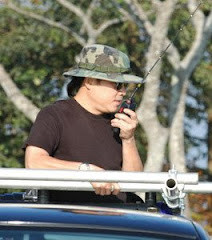
Analog + Digital = Ideas + Technology
How a Seemingly Simple Presentation Turned Into an Analogy for Our Industry
Posted by Colleen DeCourcy on 05.06.08 @ 09:56 AM
Colleen DeCourcyI was preparing to give a speech in Istanbul to our European leadership teams. I had decided I wanted to do something that would be both practical and philosophical. It was my first real presentation to the company about what our principles were going to be regarding digital: operating structures, strategy and craft. I started building the usual deck. It talked about the state of the marketplace and what clients were asking for. Then I figured I'd talk about media and thinking beyond the banner ad and the microsite. I had something about integrated teams on my list. And a reminder to define audience-centrism. But I just couldn't make myself put anything together. I couldn't make the deck. The information and I were at odds. So I talked about it with a friend who said, "Why don't you do it on an old-fashioned overhead projector ... with acetates and markers." I liked that idea. I liked what it said about ideas being what mattered, about bridging the gap between analog and digital. It was also a great way to beat my impending deadline. It would be free-form. Easy. As I moved into it, it became more complicated. And symbolic. Dan Jurow from RGA had made a comment to me at the AAAA's conference about the ruin of designing metaphors for everything. I thought about interface and how much I'd started to hate it's obviousness. I was sick of literal interpretations of tactility and narrative. I wanted the interfaces to go away ... for nothing but the content to show. I was starting to obsess about calm computing ... the shift we'd made over the last 10 years from Main Frame (many people sharing a computer) to Personal (one computer, one person), transitioning through Networked Internet (widespread distributed computing) to Ubiquitous Computing (where many computers share each of us).
It seemed to me that if we were accessing information and culture through many lenses and devices, our interfaces had to get out of the way and just facilitate. We had to find a way to deliver emotion and utility through an unseen force. An act of god? Hopefully I wouldn't need to draw my Catholic card to pull this off. Both my bosses had thrown down the gauntlet last past week at the AAAAs. It had been in the New York Times, for god's sake, that Lee Clow was looking for more from my medium, that he wasn't satisfied with what he was getting. I was both relieved and daunted to realize that whatever global strategy I shaped for digital at TBWA, it would have a meaningful call to answer. So I started creating it: the projector project. My little statement about invisible interfaces.
I decided to use the overhead projector and acetates on which I would draw -- but to bridge old and new technologies I would project some flash animations through what I drew. I wanted to create a seamless interplay between the computer and the projector that would feel like magic. The further in I got, the more the issues started becoming clear. How far from the wall would the projector be? Would my hand block the light? Would the marker lines on the acetate leave a shadow where the acetate wasn't completely flat on the platen and make the generated flash content look artificial beside them? I was dealing with an analog/digital conundrum. One reacted to the principles of physical nature and one didn't. How about the slides written on the fly -- would my handwriting start becoming scratchy and slanted as I picked up speed? Would it distract me too much from speaking? If a thing was so entirely free form, would I lose control over it? I started playing with light sources on the wall. By 3 a.m. my Tolomeo desk lamp was bungied to the dining table chair and slanted onto the wall. Now trying to figure out size -- how big should the presets be to make the video seamless?
What would I do about the fact that the slightest variation in the positioning of the projector on the stage would misalign the video insets we were projecting in flash? As I solved those problems, my ideas about what I wanted to say changed. What I was starting to realize was that you can't really understand any problem until you start to solve it. That one of our biggest problems as an industry is that we've stopped making things. We strategize, we opine, we deal with concepts. We don't make things with our hands. When it comes to digital, this is a problem. It means the industry is lacking a fundamental understanding of the physics of the medium. It has never buried it's hands in the clay.
In the end, the presentation was an interface. It was natural in it's properties and it felt organic when I touched it. In my tests, when I hit the flash trigger at just the right moment to choreograph a movement with a wave of my hand, I felt happy. I liked repeating the magic moments again and again. Was this engagement? As I watched the Apple video banner over and over, trying to line up the end of the marker drawing on the page with the start of the spot I realized that I loved that content and I wanted my graphical timing to echo the comedic timing of the writing. By the morning I was very much in love with my little experiment in analog/digital co-creation.
I arrived in Istanbul to discover that the room was too big. I couldn't use my projector; it didn't have the reach required for such a large audience. Ah, I was going to have to use technology after all. So we started again. This time we built a digital presentation, in Flash. But the principles of what I had laid down as my computer/human interaction model informed everything we did. No gratuitous animations, no viral trickery or metaphorical navigation. When it was finished we had a basic delivery structure that would let me say anything I wanted to as immediately as it occurred to me. Something I could re-use again and again as my thoughts about what we were doing here grew. The presentation I now have on my computer is really a discussion. A place to start a conversation about what we believe in. I'm borrowing a little piece from Guy Kawasaki (stealing and re-casting to suit my thoughts as one does) to lay down as my guiding principles for our approach to the medium. It's three principles (the parenthetical commentary is mine):
Make Meaning (don't just transmit concepts)
Right a Wrong (the digital industry has codified itself with the old rules and we need to set ourselves back on track)
Prevent the end of something good (advertising is a large part of culture. Let's not watch it die) By the time you read this I will have already been on stage. The speech will be, for me, both the end and the beginning of a journey. In the weeks to come I'm going to use this post as a jumping off point for an ongoing update on what happens when analog meets digital in the advertising industry. Less of an answer than a revealing set of questions and musings.





























































































































